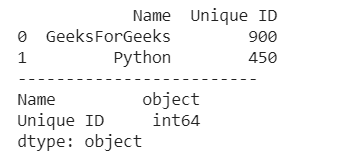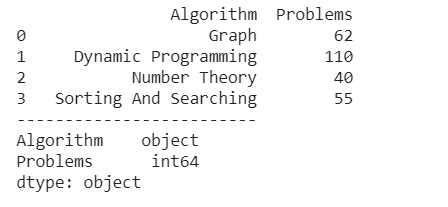How to Convert String to Integer in Pandas DataFrame?
Last Updated :
16 Feb, 2022
Let’s see methods to convert string to an integer in Pandas DataFrame:
Method 1: Use of Series.astype() method.
Syntax: Series.astype(dtype, copy=True, errors=’raise’)
Parameters: This method will take following parameters:
- dtype: Data type to convert the series into. (for example str, float, int).
- copy: Makes a copy of dataframe/series.
- errors: Error raising on conversion to invalid data type. For example dict to string. ‘raise’ will raise the error and ‘ignore’ will pass without raising error.
Return: Series with changed data type.
One of the most effective approaches is Pandas astype(). It is used to modify a set of data types. The columns are imported as the data frame is created from a csv file and the data type is configured automatically which several times is not what it should have. For instance, a salary column may be imported as a string but we have to convert it into float to do operations.
Example 1:
Python3
import pandas as pd
Data = {'Name': ['GeeksForGeeks','Python'],
'Unique ID': ['900','450']}
df = pd.DataFrame(Data)
df['Unique ID'] = df['Unique ID'].astype(int)
print (df)
print("-"*25)
print (df.dtypes)
|
Output :

Example 2:
Python3
import pandas as pd
Data = {'Algorithm': ['Graph', 'Dynamic Programming',
'Number Theory',
' Sorting And Searching'],
'Problems': ['62', '110', '40', '55']}
df = pd.DataFrame(Data)
df['Problems'] = df['Problems'].astype(int)
print (df)
print("-"*25)
print (df.dtypes)
|
Output :

Method 2: Use of pandas.to_numeric () method.
Syntax: pandas.to_numeric(arg, errors=’raise’, downcast=None)
Parameters: This method will take following parameters:
- arg: list, tuple, 1-d array, or Series.
- errors: {‘ignore’, ‘raise’, ‘coerce’}, default ‘raise’
-> If ‘raise’, then invalid parsing will raise an exception
-> If ‘coerce’, then invalid parsing will be set as NaN
-> If ‘ignore’, then invalid parsing will return the input
- downcast: [default None] If not None, and if the data has been successfully cast to a numerical dtype downcast that resulting data to the smallest numerical dtype possible according to the following rules:
-> ‘integer’ or ‘signed’: smallest signed int dtype (min.: np.int8)
-> ‘unsigned’: smallest unsigned int dtype (min.: np.uint8)
-> ‘float’: smallest float dtype (min.: np.float32)
Returns: numeric if parsing succeeded. Note that return type depends on input. Series if Series, otherwise ndarray.
pandas.to numeric() is one of the widely used methods in order to convert argument to a numeric form in Pandas.
Example 1:
Python3
import pandas as pd
Data = {'Name': ['GeeksForGeeks','Python'],
'Unique ID': ['900','450']}
df = pd.DataFrame(Data)
df['Unique ID'] = pd.to_numeric(df['Unique ID'])
print (df)
print("-"*30)
print (df.dtypes)
|
Output :

Example 2:
Python3
import pandas as pd
Data = {'Algorithm': ['Graph', 'Dynamic Programming',
'Number Theory',
' Sorting And Searching'],
'Problems': ['62', '110', '40', '55']}
df = pd.DataFrame(Data)
df['Problems'] = pd.to_numeric(df['Problems'])
print (df)
print("-"*30)
print (df.dtypes)
|
Output :

Like Article
Suggest improvement
Share your thoughts in the comments
Please Login to comment...